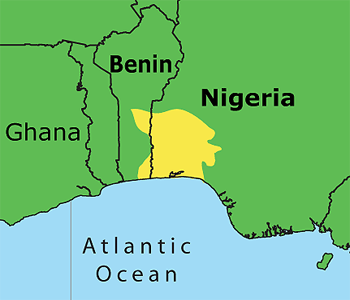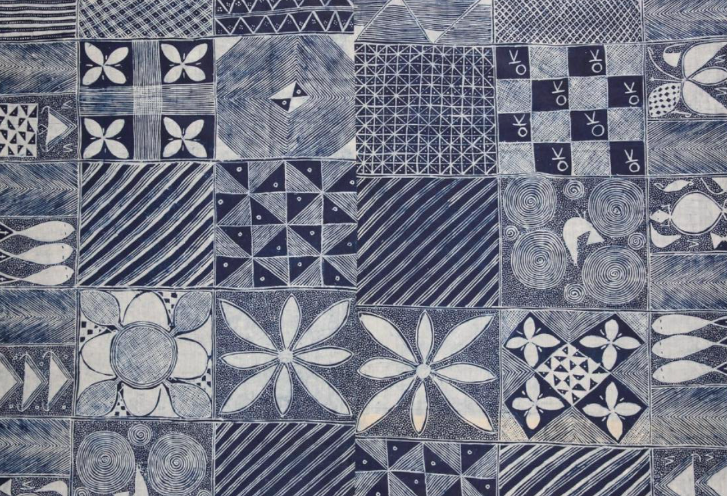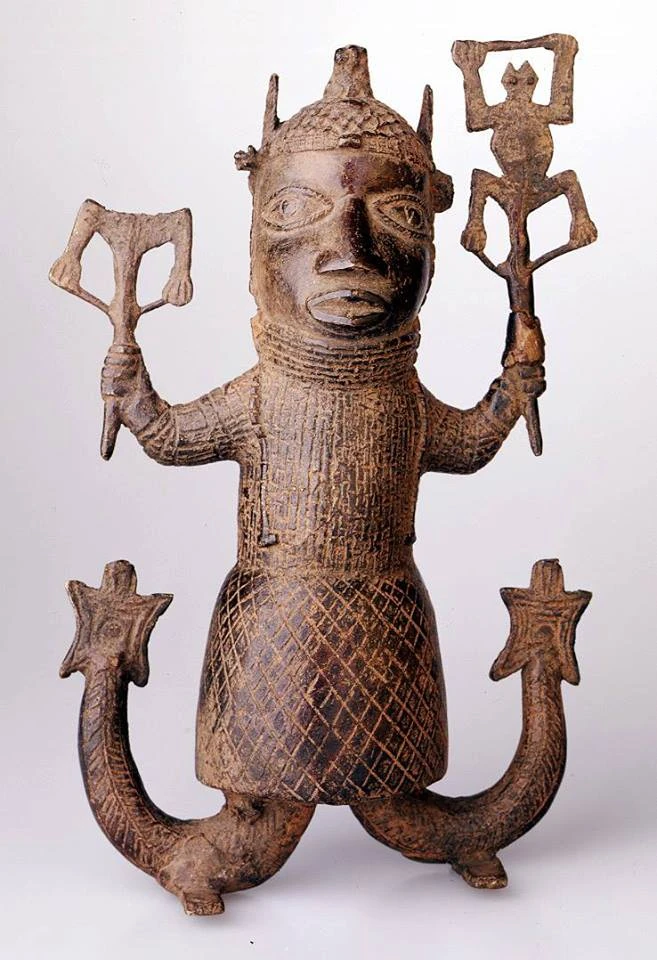The Story
Olokun challenges sky god Olorun to a weaving contest. The supreme god does not wish to compete personally so he sends his messenger, Agemo, the Chameleon to take his place. Each time Olokun appears in a splendid attire, the chameleon is able to mirror the hues and intricate patterns. Olokun is outwitted and has to admit her defeat.

The Creation Myth
Olokun has in fact already challenged Olorun. In the beginning there was only the sky, realm of Olorun and mushy waters, domain of Olokun. A minor deity, Obatala convinced Olorun to let him dry up some land so that humans could live there. Olokun was furious of this diminishment of her realm. She flooded the land and wiped out the newly created humanity.
We have all the components of a creation myth. These myths in different cultures explain the origin of the world and of life. They feature one or all of these elements:
- Creation of the world from nothing (ex nihilo) or transformation from chaos to cosmos by separation of the primordial elements.
- Rivalry between gods for the supreme power.
- Flooding. The first humans are usually destroyed (either because they are evil or simply victims of the quarrel between the gods.
For instance, in Greek mythology, the world was created out of chaos, first came the reign of Saturn who was killed by his son Zeus who instituted a new order. He ruled over sky and earth, his brother Poseidon over the oceans, his other brother Hades over the Underworld.
The evil doings of men made him angry and he flooded the lands killing them sparing Deucalion and Pyrrha who created a new humanity.
It has been said that the opposition between Olorun and Olokun is the opposition between a structured, rational male order and female chaos, primordial nature, unfettered by rules. This is only partly true since Olokun is either male or female depending on the regions.
The Weaving Contest
We begin with a cosmic, epic battle and go on with a beauty pageant. This seems a let down. We must remember that these stories were transmitted orally to a live audience. After frightening the public with the flood, the storyteller made them laugh. There are comic elements in the episode starting with the arrival of the Chameleon on the back of a snail.
Some have noticed similarities with the Greek myth of Arachne. She was a young maiden who took pride in her weaving skills. She boasted she was even better than goddess Athena. However she was defeated and was changed into a spider.
Is this similarity a coincidence or must we consider that the stories were transmitted generation after generation and could have been influenced by elements of European culture during the slave trade and colonization ? In some pictures, Olokun is identified with Greek god Poseidon and holds a trident.
The weaving contest seems futile and trivial and lacking of epic grandeur but we must not neglect the economical stakes underlying the tale. Textile industry was and is an important economical activity in Africa. There is even nowadays a pattern called Olokun used on Adire cloth. The cotton is hand- painted and indigo dyed by techniques transmitted from mothers to daughters.

The cloth is divided in squares decorated with traditional motifs. So Olokun who was at first angry with men became a benevolent goddess for the new humanity, creating wealth through the development of crafts and arts. She is also said to have invented the technique of making beads which played such an important role in trade.
The Mirror Theme
Some versions of the story say that before the contest, Olokun looked at herself in a mirror to make sure of her beauty. This reminds us of course of Snow-White’s step-mother and her mirror. A recent study has shown the importance of mirrors throughout Africa. Before the fifteenth century, there were no mirrors but people used the reflecting surface of water. With the arrival of Europeans, small mirrors became extremely popular. Olokun was the goddess of the oceans and her waters were used as a mirror. Later on little mirrors featured among the objects placed in her shrine.

However these mirrors were not used to contemplate vainly one’s image, they did not promote narcissism. They were portals to the Invisible, they offered images of the Spirits and dead ancestors. They played a great part in divination and initiation rites.
Therefore, Olokun who is associated with mirrors as goddess of water and reflecting surfaces makes a vain and frivolous use of what was a religious tool. The chameleon was about to crush her vanity. Each time she appears in magnificent robes, the chameleon imitates the colors and patterns. He becomes a mirror. It is of course an illusion. He does not really create a new fabric, he just gives an image of it just as the reflection in the mirror is not the reality. But he is also a mirror of truth : he shows Olokun what she really is , a vain and pretentious creature. So yes the story reminds us of Snow White but the meanings of the mirror are deeply rooted in African culture.
The Chameleon
The chameleon often appears in African mythology ( with variations from one area to the other). He is a totem animal and figures on ritual objects, headdresses and masks.
For the Yoruba peoples and others, he was the messenger between Olorun and the other gods and between the gods and humans. He could change into the seven colors of the rainbow, a bow that links Earth to sky. In Greek mythology, Iris, the rainbow goddess, is also a messenger. But Africans imagined a little lizard and the Greek a young woman with wings.
The chameleon has all the qualities to be a good and cunning messenger:
- Eyes that can rotate and see everything
- A slow and cautious way of walking
- A long tongue that can snatch its prey at a distance when least expected
- It can change its color. In a positive way, this means he can adapt to any situation or public, and show tact, diplomacy, using the right words at the right moment. In a negative way, it means hypocrisy, versatility, the art of flattery and lying to get what he wants. Not very moral but very efficient in politics. A former president of Benin was nicknamed the Chameleon. Agemo shares many qualities with Greek god Hermes, messenger, god of trade, of stealers, of rhetoric.
- He belongs to a group of deities around the world called tricksters.
- He outwits Olokun by a trick and illusion. He does not weave a fabric, he does not dye it. He dazzles and blinds the eyes and the mind. The means are not very honorable but cosmic peace is restored and Olokun accepts that part of her ocean will become land fit for humans. In some pictures, she holds tightly in her hands two lizards. Has she really lost? Is there a part of the story that remains untold?

The episode of the contest between Olokun and the Chameleon shows us how storytelling works. There are many versions and variations. Some elements are universal, other deeply rooted in African beliefs. Some elements are obviously influenced by other cultures.
Is it too far-fetched to compare the chameleon to Artificial Intelligence? He can imitate with great virtuosity just as IA can create a Picasso or a Vermeer but can he be original? With sophisticated images, the imitator can steal the glory of the creator. Something to reflect upon.
Source: openedition.org
Image Source: wikimedia.org, static.wikia.nocookie.net
